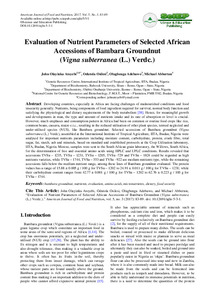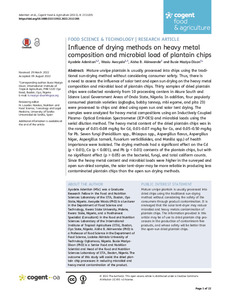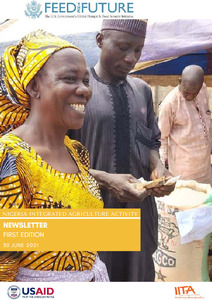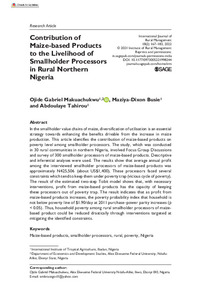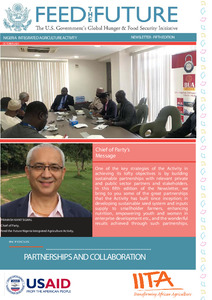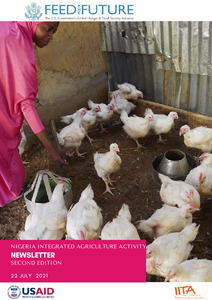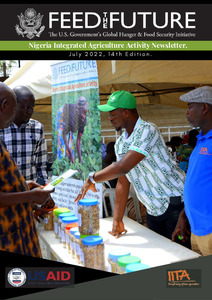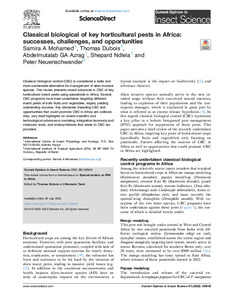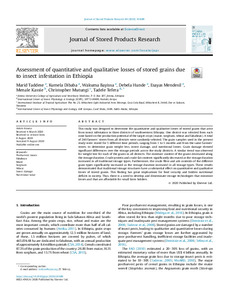Welcome to the International Institute of Tropical Agriculture Research Repository
IITA Bibliography System: Recent submissions
Now showing items 941-960 of 8102
-
Quantification of selected anti - nutrients and bioactive compounds in African Bambara Groundnut (Vigna subterranea (L.) verdc.)
(2018)Bioactive compounds in plants, being secondary metabolites are important phyto-chemicals, that form the basis of modern pharmacology and medical treatment because it has natural beneficial compounds such as in nutraceuticals, micronutrients e.t.c. Neglected legumes like Bambara groundnut (Vigna subterranea (L.) Verdc.) can serve as a high nutrient pulse and also as food supplements. However, despite the fact that Bambara groundnut contains these beneficial bioactive compounds, it also has some ... -
Morphological characterisation of selected African accessions of bambara groundnut (Vigna subterranea (L.) verdc.)
(2017)Three hundred (300) accessions of Bambara groundnut (Vigna subterranea (L.) Verdc) among the 1973 maintained in the global repository at the International Institute of Tropical Agriculture (IITA), Ibadan, genebank were selected for this study. Two to three seeds of each accession were planted during the 2014 / 2015 planting season at IITA, Ibadan, Nigeria. Seedlings were thinned to a single plant prior to flowering. Thirty - seven (37) agro-morphological parameters, representing 28 quantitative ... -
Evaluation of nutrient parameters of selected African accessions of Bambara groundnut (Vigna subterranea (L.) verdc.)
(2017)Developing countries, especially in Africa are facing challenges of malnourished conditions and food insecurity generally. Nutrients, being components of food ingredient required for survival, normal body function and satisfying the physiological and dietary requirements of the body metabolism [38]. Hence, for meaningful growth and developments in man, the type and amount of nutrients intake and its rate of absorption or level is crucial. However, much emphases and consumption pattern in Africa ... -
Influence of drying methods on heavy metal composition and microbial load of plantain chips
(2022)Mature unripe plantain is usually processed into chips using the traditional sun-drying method without considering consumer safety. Thus, there is a need to assess the influence of solar tent and open sun drying on the heavy metal composition and microbial load of plantain chips. Thirty samples of dried plantain chips were collected randomly from 10 processing centers in Akure South and Idanre Local Government Areas of Ondo State, Nigeria. In addition, four popularly consumed plantain varieties ... -
From fruit growth to ripening in plantain: a careful balance between carbohydrate synthesis and breakdown
(2022-08-11)In this study, we aimed to investigate for the first time different fruit development stages in plantain banana in order gain insights into the order of appearance and dominance of specific enzymes and fluxes. We examined fruit development in two plantain banana cultivars during the period between 2–12 weeks after bunch emergence using high-throughput proteomics, quantification of major metabolites, and analyses of metabolic fluxes. Starch synthesis and breakdown are processes that take place ... -
Can improved cassava genotypes from the breeding program substitute the adopted variety for gari production? Biophysical and textural attributes approach
(2022)The use of the biophysical and textural attributes of gari/eba to determine the possible substitution of an adopted cassava variety (TMBE419) with the improved genotypes from the breeding program was evaluated in this study. Standard methods were used for the characterization of the biophysical and textural attributes of the gari/eba from dierent cassava roots. It was observed that the mean of the biophysical attributes of the gari is swelling power (SWP) 12.46%, dispersibility 59.70%, water ... -
Feed the Future: Nigeria Integrated Agriculture Activity
(United States Government, 2021-06-30) -
Contribution of maize-based products to the livelihood of smallholder processors in rural northern Nigeria
(2022)In the smallholder value chains of maize, diversification of utilisation is an essential strategy towards enhancing the benefits drivable from the increase in maize production. This article identifies the contribution of maize-based products on poverty level among smallholder processors. The study, which was conducted in 30 rural communities in northern Nigeria, involved Focus Group Discussions and survey of 300 smallholder processors of maize-based products. Descriptive and inferential analyses ... -
Comparison of UAV and SAR performance for crop type classification using machine learning algorithms: a case study of humid forest ecology experimental research site of west Africa
(2022)Food insecurity is one of the major challenges facing African countries; therefore, timely and accurate information on agricultural production is essential to feed the growing population on the continent. A synergistic approach comprising a high-resolution multispectral UAV optical dataset and synthetic aperture radar (SAR) can help understand spectral features of target objects, especially with crop type identification. We conducted this work on the experimental plots using high spatial resolution ... -
Development initiative for northern Uganda: women in leadership: achieving an equal future in a Covid-19 world
(International Institute of Tropical Agriculture, 2021-02-26) -
Feed the Future: Nigeria Integrated Agriculture Activity
(United States Government, 2021-10-14) -
Feed the Future: Nigeria Integrated Agriculture Activity
(United States Government, 2021-07-22) -
Feed the Future: Nigeria Integrated Agriculture Activity
(United States Government, 2021-11) -
Feed the Future: Nigeria Integrated Agriculture Activity
(United States Government, 2022-07) -
The Seeds: Start Them Early Program
(International Institute of Tropical Agriculture, 2022-02) -
Classical biological of key horticultural pests in Africa: successes, challenges, and opportunities
(2022-10)Classical biological control (CBC) is considered a safer and more sustainable alternative for management of alien-invasive species. This review presents recent advances in CBC of key horticultural insect pests using parasitoids in Africa. Several CBC programs have been undertaken targeting different insect pests of both fruits and vegetables, largely yielding outstanding success. Key obstacles impeding CBC and opportunities that could promote CBC in Africa are outlined. Also, very brief highlights ... -
Evaluation of elite and local African yam bean cultivars for yield and yield-related traits
(2022-08-12)The variability in African yam bean (AYB) accessions with respect to yield and other agronomic traits were studied for two cropping seasons (2012 and 2013) in field experiments to evaluate the growth, yield and yield components of 36 AYB accessions. The accessions differed significantly (P ≤ 0.05) in the traits studied. In 2012 Pearson correlation coefficients indicated that seed yield had significant (P ≤ 0.01) and positive relationships with total pod weight per plant (r = 0.80**), number of ... -
The Seeds: Start Them Early Program
(IInternational Institute of Tropical Agriculture, 2022-04) -
Assessment of quantitative and qualitative losses of stored grains due to insect infestation in Ethiopia
(2020-12)This study was designed to determine the quantitative and qualitative losses of stored grains that arise from insect infestation in three districts of southwestern Ethiopia. One district was selected from each zone based on the production potential of the target crops (maize, sorghum, wheat and fababean). A total of 240 farmers’ stores from all districts were randomly selected. The grain samples used in the present study were stored for 5 different time periods, ranging from 1 to 5 months and from ...



